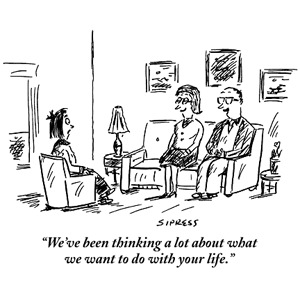
Smash the Ceiling
James Surowiecki
The truth is that the United States doesn’t need, and shouldn’t have, a debt ceiling. Every other democratic country, with the exception of Denmark, does fine without one. There’s no debt limit in the Constitution. And, if Congress really wants to hold down government debt, it already has a way to do so that doesn’t risk economic chaos—namely, the annual budgeting process. The only reason we need to lift the debt ceiling, after all, is to pay for spending that Congress has already authorized. If the debt ceiling isn’t raised, we’ll face an absurd scenario in which Congress will have ordered the President to execute two laws that are flatly at odds with each other. If he obeys the debt ceiling, he cannot spend the money that Congress has told him to spend, which is why most government functions will be shut down. Yet if he spends the money as Congress has authorized him to he’ll end up violating the debt ceiling.
As it happens, the debt ceiling, which was adopted in 1917, did have a purpose once—it was a way for Congress to keep the President accountable. Congress used to exercise only loose control over the government budget, and the President was able to borrow money and spend money with little legislative oversight. But this hasn’t been the case since 1974; Congress now passes comprehensive budget resolutions that detail exactly how the government will tax and spend, and the Treasury Department borrows only the money that Congress allows it to. (It’s why TARP, for instance, required Congress to pass a law authorizing the Treasury to act.) This makes the debt ceiling an anachronism. These days, the debt limit actually makes the President less accountable to Congress, not more: if the ceiling isn’t raised, it’s President Obama who will be deciding which bills get paid and which don’t, with no say from Congress.
One argument you hear for having a debt ceiling is that it’s useful as what the political theorist Jon Elster calls a “precommitment device”—a way of keeping ourselves from acting recklessly in the future, like Ulysses protecting himself from the Sirens by having himself bound to the mast. As precommitment devices go, however, the debt limit is both too weak and too strong. It’s too weak because Congress can simply vote to lift it, as it has done more than seventy times in the past fifty years. But it’s too strong because its negative consequences (default, higher interest rates, financial turmoil) are disastrously out of proportion to the behavior it’s trying to regulate. For the U.S. to default now, when investors are happily lending it money at exceedingly reasonable rates, would be akin to shooting yourself in the head for failing to follow your diet.
Advocates of the ceiling like the way it turns the national debt into front-page news, focussing the minds of voters and politicians; they think it fosters accountability, straight talk, transparency. In reality, debt-ceiling votes merely perpetuate the illusion that balancing the budget is easy. That’s why politicians like the debt ceiling: it allows them to rail against borrowing more money (which voters hate) without having to vote to cut any specific programs or raise taxes (which voters also hate).
You might think that there are benefits to putting negotiators under the gun. But, as the Dutch psychologist Carsten de Dreu has shown, time pressure tends to close minds, not open them. Under time pressure, negotiators tend to rely more on stereotypes and cognitive shortcuts. They don’t consider as wide a range of alternatives, and are more likely to jump to conclusions based on scanty evidence. Time pressure also reduces the chances that an agreement will be what psychologists call “integrative”—taking everyone’s interests and values into account.
In fact, by turning dealmaking into a game of chicken, the debt ceiling favors fanaticism. As the economist Thomas Schelling showed many years ago, “It does not always help to be, or to be believed to be, fully rational, coolheaded, and in control of oneself” when it comes to brinksmanship. It doesn’t, in short, help to be President Obama. That may be why all the deals that have been taken seriously this season rely much more heavily on spending cuts than on tax increases: the deals represent Republican priorities, because the Republicans seem to be more willing than the Democrats to let the country default. It’s not pure craziness that’s rewarded—when some congressional Tea Partiers said that they wouldn’t vote to raise the ceiling under any circumstances, they became irrelevant to the conversation, since no compromise would make them happy. But recklessness does equal power: that’s why Eric Cantor, the House Majority Leader, and John Boehner, the Speaker of the House, have implied that they’re willing to go over the cliff (in part by suggesting that their fellow party members will force them to) but also that they can be persuaded to do the right thing.
We may nonetheless end up with a halfway sensible budget deal. But that would be the result of luck, not design. Instead of figuring out ways to raise the debt ceiling, we should simply go ahead and abolish it. The U.S. economy has plenty of real problems to deal with. We shouldn’t have to wrestle with ones we’ve created for ourselves. ♦
August 1, 2011

